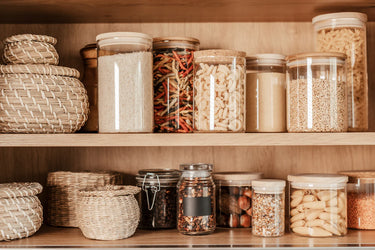The 12 Types of Knives Every Home Chef Should Have

When outfitting your kitchen, it can be easy to focus on the fancy gadgets like a high-speed blender or the sous vide machine. Dedicated cooks will tell you that it’s the knives that make all the difference. Though a chef’s knife and a paring knife are the two must-have essentials, expanding beyond these two knives can be rewarding. The right knife for the right task (as in, a tomato knife for tomatoes, a bread knife for bread) not only protects the blades of each knife, the design is suited to certain methods of cutting, chopping, and slicing. (Psst…As you grow your collection, you’ll be in need of a storage solution. Our magnetic knife block allows for easy access that doesn’t hog counter space.)
Here’s our guide to the 12 types of knives every home chef should have.
-
Chef’s Knife
Put any cook worth their salt into a kitchen and they’re able to navigate with a chef’s knife alone. This long, tapered blade is generally around 8-inches long. It a go-to for day-to-day cooking for a reason: a chef’s knife is perfect for slicing, chopping, mincing, and dicing. The large blade makes quick work of heavy-duty vegetables like potatoes or thick carrots, but is gentle enough to turn piles of fresh herbs into confetti. The tapered point of a chef’s knife is idea for more delicate work like scoring the skin of a fish, coring a tomato, or anywhere you want to make a small, precise cut. To smash garlic cloves with ease, rotate the blade on its side and press firmly to release the skin. Use a chef’s knife to open an avocado and remove the stone. Because you’re likely to reach for a chef’s knife most often, it’s important to keep the blade sharp. Use a honing steel regularly, and invest in a good knife-sharpening device, or seek out someone who can do it locally for you.
-
Paring Knife
Though the blade is normally just 3.5 inches long, a paring knife is a handy kitchen companion. Use it for smaller, more intricate tasks tasks like peeling, deseeding, coring, and trimming. A paring knife is much better than a chef’s knife at tasks like deveining shrimp and coring strawberries. For small, off-the-cuff cooking and prep tasks, a paring knife can often do the job. For example, slicing one hard boiled egg for an open-faced sandwich is easy with a paring knife, but for a big batch egg salad, a chef’s knife is a better pick.
-
Utility Knife
A utility knife features a medium-sized blade and—as the name suggests—it’s at home with a variety of tasks. Choose it for slicing fruits, cooked meats and vegetables, and soft bread. It’s not a good choice for hardy-skinned squashes or other heavy-duty prep, but can slice up any cooked dish with ease. If you prefer peeling vegetables with a knife rather than a peeler, this knife is a good pick.
-
Boning Knife
There are no mysteries here: a boning knife does what the name suggests. Good for removing bones from raw meat and fish, these knives feature a six-inch blade that can either be flexible or firm. Choose a flexible boning knife for fish and poultry and a stiff blade for thick cuts of meat like beef or pork.
-
Bread Knife
Long, with a serrated edge, a bread knife can through the thickest sourdough crust with ease. Thanks to the saw-like design, it can slice easily through tender crumbs without tearing. Use it to cut corn kernels off the cob or to slice tomatoes, in a pinch.
-
Cleaver, aka Butcher Knife
The flat, rectangular blade of a cleaver might look intimidating, but it’s there to make your life easier. This heavy, broad knife is strong enough to slice through bones and thick cuts of meat, which is why it’s the preferred tool of butchers.
-
Carving Knife
On Thanksgiving day, you’ll be grateful to have a classic carving knife in your arsenal. This long, slim effortlessly glides through roasts. Use it for everything from poultry to lamb to beef. It’ll come in handy in the summertime, too, to turn juicy watermelons into wedges.
-
Santoku Knife
Hailing from Japan, the santoku design of knives looks a bit like a chef’s knife turned upside down. The flat-edged blade of a santoku knife has dimpled sides, which keeps food from sticking to the knife as you cut. It’s ideal for cutting raw fish, but it’s just as great for prepping vegetables.
-
Fillet Knife
Dedicated fish lovers know that there are few pleasures as deep as a whole fish deboned at home. A fillet knife is key for prepping a fish, since the long, slender blade is flexible enough to slice through skin and remove small bones, all while keeping the flesh intact.
-
Nakiri Knife
No, a nakiri knife isn’t a baby cleaver, but you’d be forgiven for thinking so given their similar shapes. This knife was the traditional style for cutting vegetables in Japan. Use it as your go-to for prepping vegetables—seriously, you won’t go back after shredding a cabbage with this knife.
-
Cheese Knife
It’s not hard to convince a French person that you need specific knives for cheese, because they know the truth: there is a right knife for each kind of cheese. Don’t worry, you can use the same knife for Parmesan as Grana Padano. But, a small knife with holes in the blade is best for soft cheese like Brie, while a cheese spade with a sharp tip (sometimes these will have a slightly serrated edge, too) is best for harder cheeses.
-
Tomato Knife
A gloriously juicy, in-season tomato deserves the best treatment. A tomato knife is about the size of a paring knife but has a serrated edge and will slice through the skin with ease.





